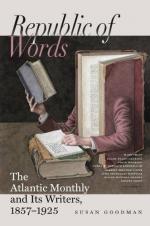requires no advocate and no defence. Its great
proprietor, the Public, is perfectly satisfied with
his purchase and his agents. He thinks himself
providentially guided in the choice of his Superintendent,
and does not vainly pique himself upon his sagacity
in selecting Mr. Frederick Law Olmsted for the post.
This gentleman, in his place, offsets at least a thousand
square plugs in round holes. He is precisely
the man for the place,—and that is precisely
the place for the man. Among final causes, it
would be difficult not to assign the Central Park
as the reason of his existence. To fill the duties
of his office as he has filled them,—to
prove himself equally competent as original designer,
patient executor, potent disciplinarian, and model
police-officer,—to enforce a method, precision,
and strictness, equally marked in the workmanship,
in the accounts, and in the police of the Park,—to
be equally studious of the highest possible use and
enjoyment of the work by the public of to-day, and
of the prospects and privileges of the coming generations,—to
sympathize with the outside people, while in the closest
fellowship with the inside,—to make himself
equally the favorite and friend of the people and of
the workmen: this proves an original adaptation,
most carefully improved, which we seriously believe
not capable of being paralleled in any other public
work, of similar magnitude, ever undertaken. The
union of prosaic sense with poetical feeling, of democratic
sympathies with refined and scholarly tastes, of punctilious
respect for facts with tender hospitality for ideas,
has enabled him to appreciate and embody, both in
the conception and execution of the Park, the beau-ideal
of a people’s pleasure-ground. If he had
not borne, as an agriculturist, and as the keenest,
most candid, and instructive of all our writers on
the moral and political economy of our American Slavery,
a name to be long remembered, he might safely trust
his reputation to the keeping of New York city and
all her successive citizens, as the author and achiever
of the Central Park,—which, when completed,
will prove, we are confident, the most splendid, satisfactory,
and popular park in the world.
Two grand assumptions have controlled the design from
the inception.
First, That the Park would be the only park deserving
the name, for a town of twice or thrice the present
population of New York; that this town would be built
compactly around it (and in this respect of centrality
it would differ from any extant metropolitan park of
magnitude); and that it would be a town of greater
wealth and more luxurious demands than any now existing.
Second, That, while in harmony with the luxury of
the rich, the Park should and would be used more than
any existing park by people of moderate wealth and
by poor people, and that its use by these people must
be made safe, convenient, agreeable; that they must
be expected to have a pride and pleasure in using
it rightly, in cherishing and protecting it against
all causes of injury and dilapidation, and that this
is to be provided for and encouraged.




